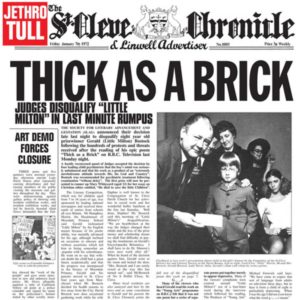Reprise 2072
Producer: Jethro Tull
Track listing: Thick as a Brick / Thick as a Brick

June 3, 1972
2 weeks
Jethro Tull’s back-to-back Number One albums, 1972’s Thick as a Brick and 1973’s A Passion Play are two of the most uncommercial and uncompromising albums ever to top the Billboard album chart.
Named after the 18th-century inventor of the seed drill, Jethro Tull was formed in 1968 in Blackpool, England. After its initial success in the U.K., the group began to establish a following in America with its third album, 1970’s Benefit, which climbed to number 11 and went gold. The follow-up, 1971’s Aqualung, featured several tracks, such as “Locomotive Breath,” which became standards on the burgeoning album rock radio format. The album went on to sell more than two million copies in America, setting the stage for Thick as a Brick.
“It was the first time Jethro Tull really did a concept album,” says singer/flautist Ian Anderson. “We were wrongly accused of having made a concept album with Aqualung. To me it was just a song collection. However, we got this sort of tag as being a concept-album group. My reaction to that was to come up with the material for the follow-up album, Thick as a Brick, as almost a parody of what a concept album might be.”
Thick as a Brick was conceived and recorded as one piece of music nearly 44 minutes long, broken into two parts to accommodate the two sides of an album. The cover featured a mock newspaper called the St. Cleve Chronicle with stories relating to the album, including a lead piece on the Gerald (Little Milton) Bostock, a fictitious eight-year-old boy who shared writing credits with Anderson.
“It was definitely a conceptualized piece of music and lyric, but it was done with a sense of fun,” Anderson explains. “Lyrically, a lot of the ideas and sentiments expressed are my own somewhat contradictory views and emotions I had as a child or young teenager. It kind of added to the humor of it for me to pretend that these were the sentiments of a rather precocious eight-year-old.”
The album was written, composed and arranged over a grueling month-long period with a lineup that included Anderson taking on violin, sax, and trumpet chores, as well as his usual lead vocals, flute, and acoustic guitar; Martin Barre on electric guitar and lute; John Evan on organ, piano, and harpsichord; Jeffrey Hammond-Hammond on bass; and Barriemore Barlow on percussion. “Everyday I would write a new piece of music,” Anderson recalls. “I would meet the guys at the rehearsal room and we would build up the song from the day before. We always finished rehearsal around tea time and I would have the evening and a couple of hours the next morning to work on the next piece of music.”
Yet the actual recording process went fairly quickly. Says Anderson, “After we had the whole piece organized, we went in and recorded it, which only took about two weeks. In fact, it took longer to do the album cover than to record the album.”
THE TOP FIVE
Week of June 3, 1972
1. Thick as a Brick, Jethro Tull
2. First Take, Robert Flack
3. Harvest, Neil Young
4. Crosby & Nash, Crosby & Nash
5. Manassas, Stephen Stills
